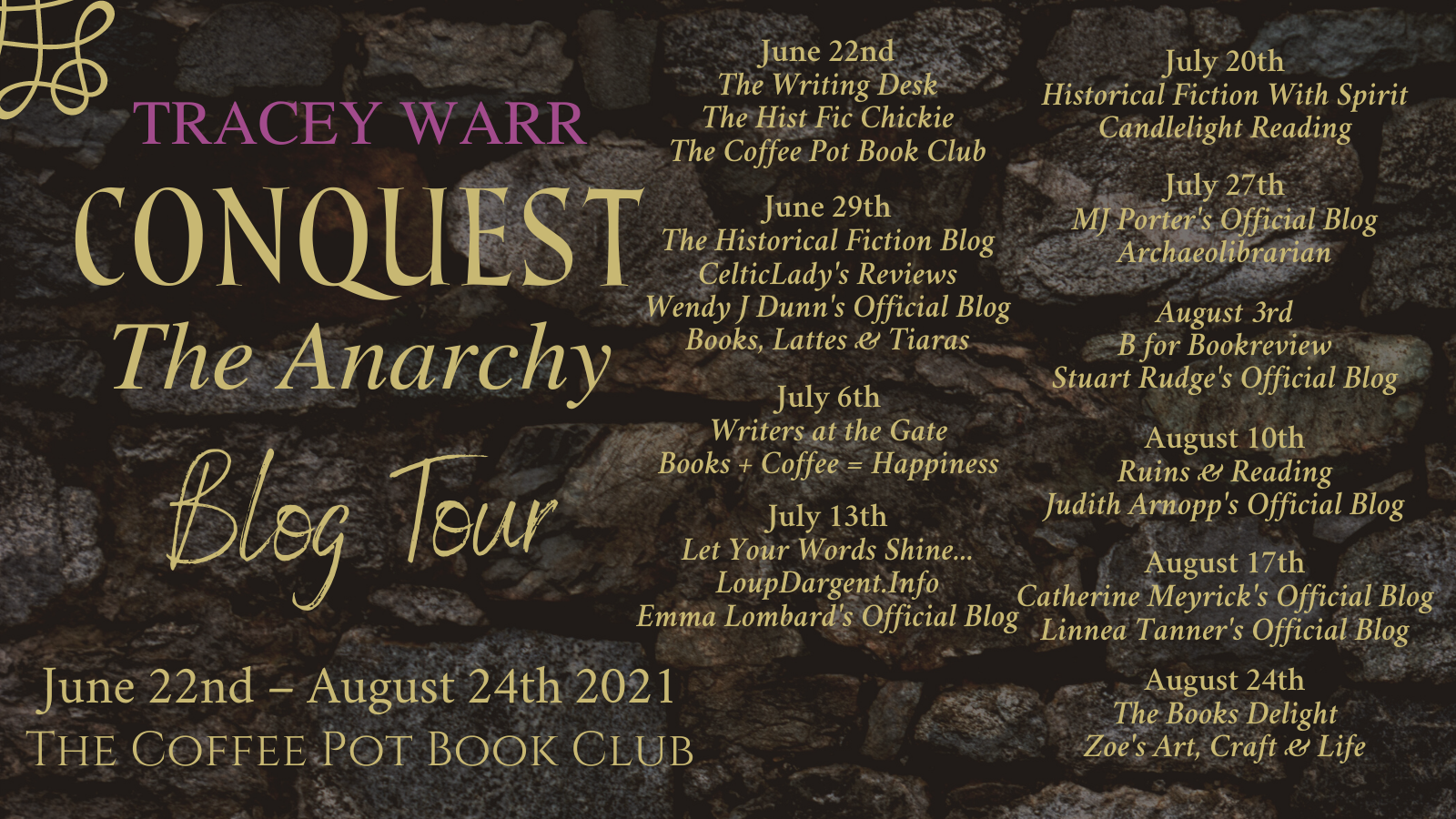
17 Aug Tracey Warr The Anarchy Coffee Pot Book Club Blog Tour #HistoricalFiction #Medieval #BlogTour #CoffeePotBookClub @TraceyWarr1 @maryanneyarde
FEATURED AUTHOR: BARBARA GREIG
It is my pleasure to feature Tacey Warr as part of The Coffee Pot Book Club Blog Tour being held from June 22nd – August 24th, 2021. Tracey Warr is the author of the historical fiction/historical romance novel, The Anarchy (Conquest, Book 3), which was released by Impress Books on 2nd June 2020 (218 pages).
Below are highlights of The Anarchy, Tracey Warrr’s author bio, and a guest post.
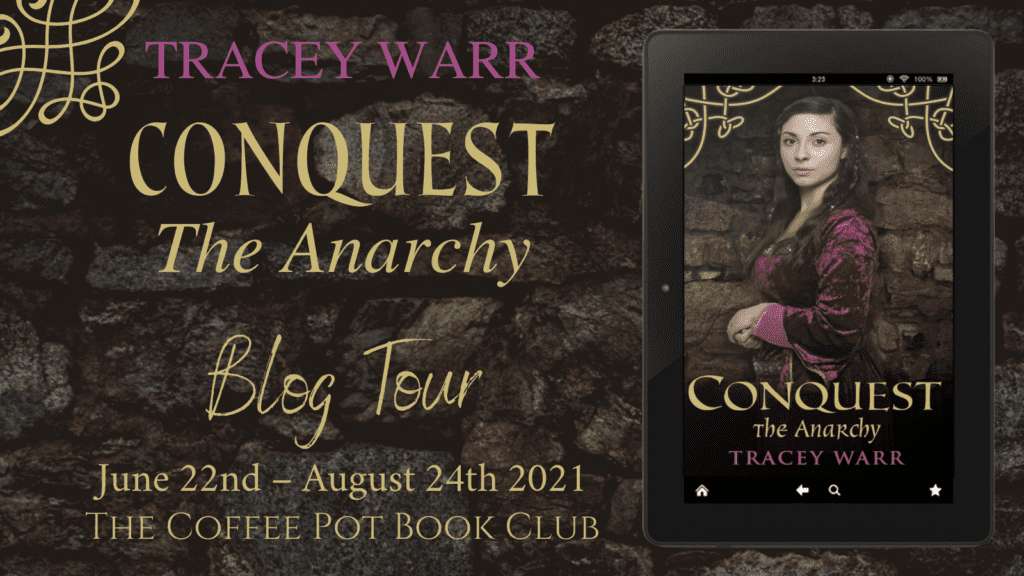
HIGHLIGHTS: THE ANARCHY
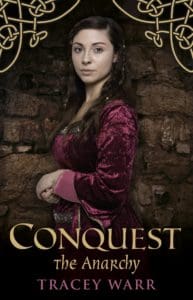
The Anarchy
(Conquest, Book 3)
By Tracey Warr
(blurb)
Unhappily married to Stephen de Marais, the Welsh princess, Nest, becomes increasingly embroiled in her countrymen’s resistance to the Norman occupation of her family lands. She plans to visit King Henry in the hope of securing a life away from her unwanted husband, but grieving for the loss of his son, the King is obsessed with relics and prophecies.
Meanwhile, Haith tries to avoid the reality that Nest is married to another man by distracting himself with the mystery of the shipwreck in which the King’s heir drowned. As Haith pieces together fragments of the tragedy, he discovers a chest full of secrets, but will the revelations bring a culprit to light and aid the grieving King?
Will the two lovers be united as Nest fights for independence and Haith struggles to protect King Henry?
Buy Links:
Universal Links:
The Daughter of the Last King (Book 1)
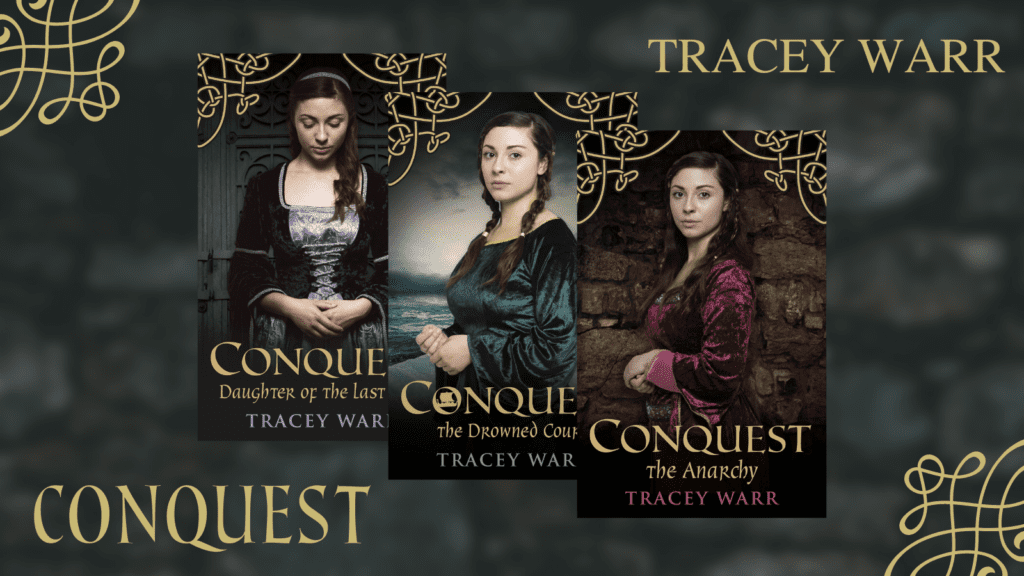
Retail Links to The Anarchy:
Amazon UK ♥ Amazon US ♥ Amazon CA ♥ Amazon AU ♥ Barnes and Noble ♥ Waterstones ♥ Kobo
AUTHOR BIO: TRACEY WARR

Tracey Warr (1958- ) was born in London and lives in the UK and France. Her first historical novel, Almodis the Peaceweaver (Impress, 2011) is set in 11th century France and Spain and is a fictionalised account of the true story of the Occitan female lord, Almodis de la Marche, who was Countess of Toulouse and Barcelona. It was shortlisted for the Impress Prize for New Fiction and the Rome Film Festival Books Initiative and won a Santander Research Award. Her second novel, The Viking Hostage, set in 10th century France and Wales, was published by Impress Books in 2014 and topped the Amazon Australia charts. Her Conquest trilogy, Daughter of the Last King, The Drowned Court, and The Anarchy recount the story of a Welsh noblewoman caught up in the struggle between the Welsh and the Normans in the 12th century. She was awarded a Literature Wales Writers Bursary. Her writing is a weave of researched history and imagined stories in the gaps in history.
Tracey Warr studied English at University of Hull and Oxford University, gaining a BA (Hons) and MPhil. She worked at the Arts Council, Institute of Contemporary Arts, Chatto & Windus Publishers, and edited Poetry Review magazine with Mick Imlah. She also publishes art writing on contemporary artists, and in 2016 she published a future fiction novella, Meanda, in English and French, as part of the art project, Exoplanet Lot. She recently published a series of three books, The Water Age, which are future fiction and art and writing workshop books – one for adults and one for children – on the topic of water in the future. She gained a PhD in Art History in 2007 and was Guest Professor at Bauhaus University and Senior Lecturer at Oxford Brookes University and Dartington College of Arts. Her published books on contemporary art include The Artist’s Body (Phaidon, 2000), Remote Performances in Nature and Architecture (Routledge, 2015) and The Midden (Garret, 2018). She gained an MA in Creative Writing at University of Wales Trinity St David in 2011. She is Head of Research at Dartington Trust and teaches on MA Poetics of Imagination for Dartington Arts School.
Social Media Links:
Website ♥ Twitter ♥ Facebook ♥ LinkedIn ♥ Instagram ♥ Amazon Author Page ♥ Goodreads
GUEST POST 4: TRACEY WARR
The Anarchy is set between 1121 and 1139 and recounts the turbulent life of the Welsh noblewoman Nest ferch Rhys. Nest was the daughter of the last independent king in Wales, Rhys ap Tewdwr. Her father and three of her brothers were killed by invading Normans and she was probably raised in the Norman court. She became the mistress of the Norman king, Henry I, and had a son with him. She was married to Gerald FitzWalter, the Norman steward of Pembroke Castle, which had been part of her father’s kingdom. The Welsh prince, Owain of Powys, abducted her from Gerald for a few years. After Gerald died, she was married to Stephen de Marais, the Norman constable of Cardigan Castle. Some sources also claim that she had a relationship and a son with the Flemish sheriff of Pembroke Castle, Hait. The action of the novel moves between Wales and Normandy and places in England visited by King Henry’s I’s peripatetic court including Westminster, Bristol and Dunstable.
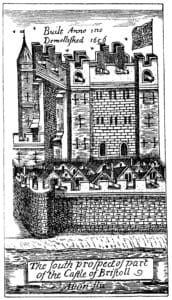
1 Bristol Castle
In The Anarchy, Nest travels from southwest Wales to meet King Henry I, her former lover, at Bristol Castle in September 1122, where she hopes to gain the king’s permission to separate from her unwelcome husband, Stephen de Marais. A Welsh heiress, though, might be used against the king by his enemies and Henry is initially reluctant to grant Nest’s request.
Nest and her female companions have to navigate rain-sodden land and treacherous river crossings to reach Bristol and when they arrive they find ‘a castle rising on a vast mound, strengthened by wall and battlements, towers and divers engines … with two rivers washing its sides’. The castle belonged to Robert, Earl of Gloucester, the king’s oldest illegitimate son, who was married to Mabel FitzHamon, Nest’s childhood friend. It stood at the confluence of the River Frome and the River Avon and was highly defensible.

2 Water Gate to Bristol Castle
The first version of the castle was built between 1066 and 1088 by Robert FitzHamon, a close associate of William the Conqueror and his son King William II. FitzHamon was entrusted with furthering the Norman invasion in southwest England into Wales. He also occupied the Norman castle at Cardiff. The first fortification was updated by Robert of Gloucester who inherited the castle through his wife, Mabel FitzHamon, and built a great stone keep.
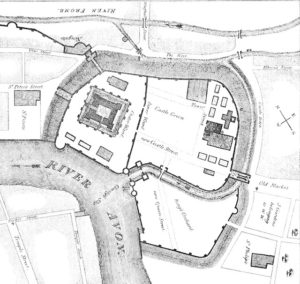
3 Plan of Bristol Castle
As an impregnable stronghold, Bristol Castle housed a number of very important prisoners, including King Henry’s older brother Robert, Duke of Normandy and later, during the civil war known as The Anarchy, King Stephen was held there in shackles after his capture at the Battle of Lincoln.
Robert of Gloucester’s seat at Bristol Castle became the centre of the civil war between Robert’s half-sister, the Empress Maud, and King Stephen. Maud held her court there on several occasions. In 1143, whilst the civil war still raged across England, Bristol Castle was considered safe enough as a location for Maud’s nine-year-old son Henry FitzEmpress to stay and receive part of his education. Henry eventually succeeded King Stephen and became King Henry II. Only a few parts of the castle keep and curtain wall remain in contemporary Bristol and are preserved in Castle Park.
Image credits
1 Bristol Castle
From JF Nicholls and John Taylor, Bristol Past and Present (Bristol: Arrowsmith, 1882). Text available at the Internet Archive, Public Domain, doi:10.1093/library/s1-V.1.86. Images by unknown engravers, and thus are PD due to age, per the relevant British legislation https://commons.wikimedia.org/w/index.php?curid=8657002
2 Water Gate to Bristol Castle
From JF Nicholls and John Taylor, Bristol Past and Present (Bristol: Arrowsmith, 1882). Text available at the Internet Archive, Public Domain, doi:10.1093/library/s1-V.1.86. Images by unknown engravers, and thus are PD due to age, per the relevant British legislation
https://commons.wikimedia.org/wiki/File:Water_Gate_to_Bristol_Castle.jpg
3 Plan of Bristol Castle
From JF Nicholls and John Taylor, Bristol Past and Present (Bristol: Arrowsmith, 1882). Text available at the Internet Archive, Public Domain, doi:10.1093/library/s1-V.1.86. Images by unknown engravers, and thus are PD due to age, per the relevant British legislation
https://commons.wikimedia.org/w/index.php?curid=8657066

@coffepotbookclub


Jan Sikes
Posted at 09:19h, 18 AugustHi, Linnea. Thank you for introducing me to this author! Her book covers are compelling!
Linnea Tanner
Posted at 09:45h, 20 AugustHi Jan–Thank you for visiting and commenting on Tracey Warr’s novel, “The Anarchy.” I also love the book covers! Have a lovely weekend!
Luciana
Posted at 00:48h, 28 AugustFascinating book and history, not quite my area of expertise, so it was nice to learn something new.
Linnea Tanner
Posted at 18:50h, 30 AugustHi Luciana–Thank you for visiting and checking out Tracey’s Warr’s novel, Anarchy. I’m starting to read more about this period and find it very interesting. It is fun to learn more about author authors and their expertise.